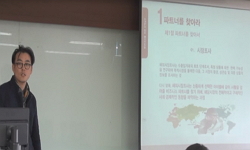The Lower Xiajiadian culture was an early Bronze Age culture that flourished in the Liaoxi area. And it has developed numerous fortress sites. Sites can be divided into stone fortresses, earthen fortresses, and sites that have no walls. Stone fortress...
http://chineseinput.net/에서 pinyin(병음)방식으로 중국어를 변환할 수 있습니다.
변환된 중국어를 복사하여 사용하시면 됩니다.
- 中文 을 입력하시려면 zhongwen을 입력하시고 space를누르시면됩니다.
- 北京 을 입력하시려면 beijing을 입력하시고 space를 누르시면 됩니다.

요서지역 하가점하층문화 취락 유적의 특징 분석 = Analysis on the characteristics of the Lower Xiajiadian culture's settlement sites in the Liaoxi area
한글로보기https://www.riss.kr/link?id=A108568407
-
저자
강승우 (동북아역사재단)

- 발행기관
- 학술지명
- 권호사항
-
발행연도
2023
-
작성언어
Korean
-
주제어
하가점하층문화 ; 석성 ; 토성 ; 고동광 ; 주거지 ; the Lower Xiajiadian culture ; stone fortresses ; earthen fortresses ; ancient copper mine ; settlement
-
등재정보
KCI등재
-
자료형태
학술저널
- 발행기관 URL
-
수록면
35-85(51쪽)
- 제공처
-
0
상세조회 -
0
다운로드
부가정보
다국어 초록 (Multilingual Abstract)
The Lower Xiajiadian culture was an early Bronze Age culture that flourished in the Liaoxi area. And it has developed numerous fortress sites. Sites can be divided into stone fortresses, earthen fortresses, and sites that have no walls. Stone fortresses constructed fortress walls using natural roughness and enhanced defensive power with various structures such as moat, bastion, and double walls.
Earthen Fortress sites are located in flat area than Stone Fortress sites. It can beseen that most of thesettlement sites overlapped and lasted for a long time, enabling stable residence. The number of general settlement sites where the walls have not been found is the largest. Through this, it can be seen that it was possible to live sufficiently without the wall. Looking at the distribution of fortress sites, the stone fortress ruins surround and defend the entire range of the Lower Xiajiadian culture.
The characteristics of the Lower Xiajiadian culture can be examined through residential areas, ritual and production remains in the settlement. Residential area using various architectural styles and materials, such as stonework, earthwork, and earth bricks was found. A number of relics have been found with dwellings, pit, and courtyard, so we can examine the characteristics of the residential area.
In addition, sites and remains related to the ritual were found. It can be seen that the ritual took place extensively. And various production facilities such as copper mine sites and molds were found, and job classification according to men and women and job differentiation were also found. Through this, it can be confirmed that the culture of the Lower Xiajiadian culture entered a complex society.
국문 초록 (Abstract)
하가점하층문화는 요서지역에서 번성했던 초기 청동기 시대의 문화로 성 유적이 발달하였다. 취락 유적은 성벽의 유무와 축성 재질에 따라 크게 석성과토성 그리고 성벽이 발견되지 않은 ...
하가점하층문화는 요서지역에서 번성했던 초기 청동기 시대의 문화로 성 유적이 발달하였다. 취락 유적은 성벽의 유무와 축성 재질에 따라 크게 석성과토성 그리고 성벽이 발견되지 않은 일반 취락 유적으로 나눌 수 있다.
석성은 천연적인 험준함을 이용하여 성벽을 쌓았고, 이와 더불어 환호, 마면, 각대, 이중 성벽 구조 등으로 방어력을 제고하였다. 토성 유적은 석성 유적보다 편평한 지역에 존재하는 편이다. 대부분 거주유적이 중첩되어 상당히 오래 지속되어 안정적인 거주가 가능했음을 알 수 있다. 성벽이 발견되지 않은일반 취락 유적들은 그 수량이 가장 많다. 이를 통해 당시 성벽이 없어도 충분히거주가 가능했다는 점을 알 수 있다. 성 유적의 분포 현상을 살펴보면, 석성 유적이 하가점하층문화 전 범위를 둘러싸고 방어하는 형상을 보여주고 있다.
취락 유적 내 주거지, 제사, 생산 유구 등을 통해 하가점하층문화 취락 유적의 특징을 살펴볼 수 있다. 성 유적과 마찬가지로 주거지를 건축할 때에도 석축, 토축, 흙벽돌을 쌓은 것과 같이 다양한 건축 양식과 재료를 사용하여 건축한 현상이 발견되었다. 다수의 유적에서 주거지와 窖穴, 담장(院牆)을 두른 院 落이 발견되어 주거지의 특징을 살펴볼 수 있다.
또 제사를 지낸 것으로 추정되는 平臺와 인골이 포함된 회갱이 여러 유적에서 발견되어 제사가 빈번하였음을 알 수 있다. 이외에 동광 유적과 요지 등 다양한 생산 시설이 발견되었고, 남녀에 따른 직업 구분과 직업의 분화 현상 등도발견되었다. 이러한 모습을 통해 당시 하가점하층문화가 복합사회에 진입하였음을 확인할 수 있다.
동일학술지(권/호) 다른 논문
-
한강 유역 신석기시대 뗀석기의 역동성 -입지 환경에 따른 신석기시대 전기 마을유적 비교 검토-
- 고조선단군학회
- 김영준
- 2023
- KCI등재
-
묘제를 통해 본 고조선문화의 정체성과 지역성 고찰 -방법론적 검토를 중심으로-
- 고조선단군학회
- 오대양
- 2023
- KCI등재
-
漢代 『方言』에 수록된 北燕지역 어휘의 언어정체성 분석 -중국 上古문헌 用例 분석을 중심으로-
- 고조선단군학회
- 정재남
- 2023
- KCI등재
-
- 고조선단군학회
- 백종오
- 2023
- KCI등재




 KCI
KCI





